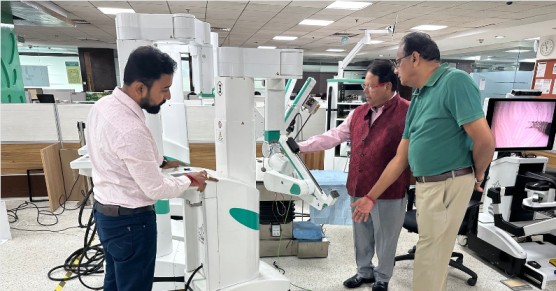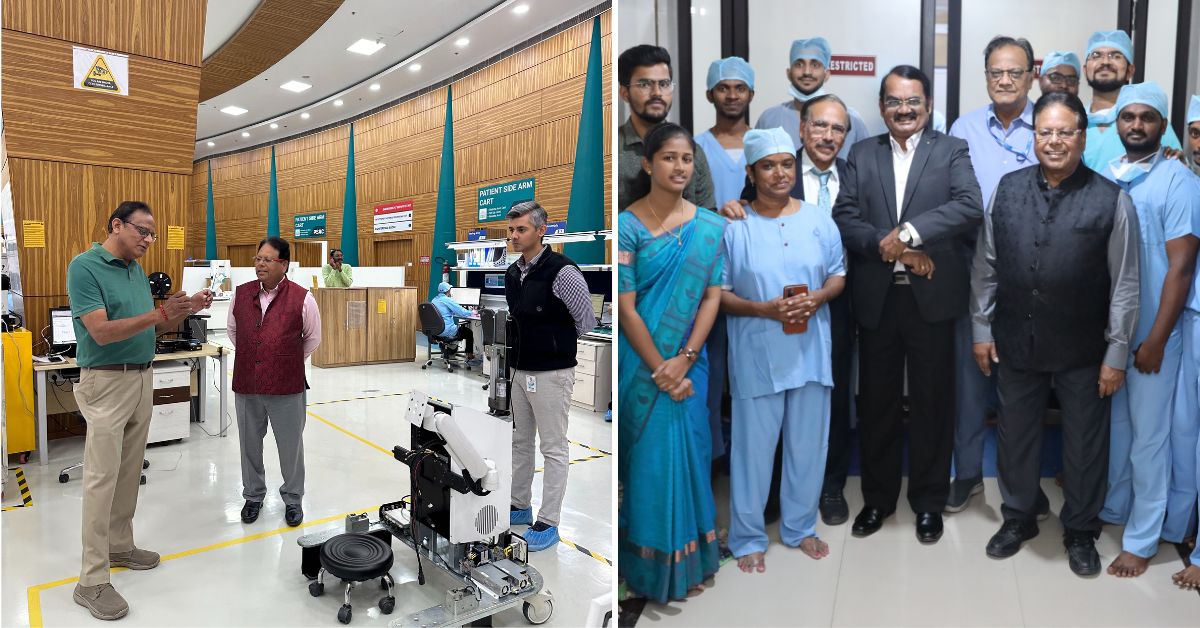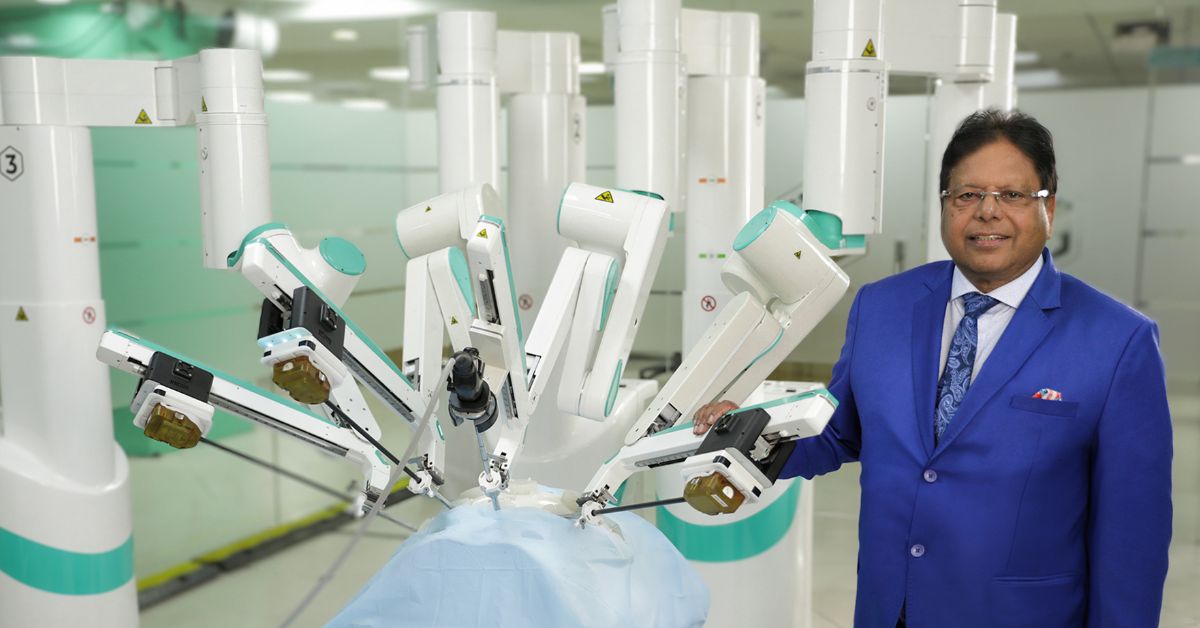During a brief encounter with a patient’s brother, Dr Sudhir Srivastava, a renowned cardiologist and the founder of SS Innovations, experienced a transformative shift in perspective regarding his work. This encounter took place during a fateful visit to India, which ultimately served as a catalyst in his journey to develop made-in-India surgical reports.
The case involved a 22-year-old female diagnosed with an atrial septal defect — a congenital heart condition characterised by a hole in the septum, the wall that separates the heart’s upper chambers (atria).
She was diagnosed quite late and was in a critical condition. The hospital was charging Rs 4 lakh for the surgery, and her brother couldn’t afford it. While the doctor volunteered to do it for free, the hospital did not.
“His brother asked for some time and tried to raise the money, but unfortunately, I never heard from them again. To be honest, it still haunts me,” Dr Sudhir recalls in a conversation with The Better India.
This incident left him with sleepless nights and a mission — to develop a cost-effective system that can help people from every background in the country.
The outcome was the creation of a surgical robot called SSI Mantra. This innovative technology assists doctors in conducting complex surgeries with precision and ease, reducing costs by one-third compared to manual surgeries.
A science company with a mission
Born in Rajasthan, Dr Sudhir moved to the US in 1972 for his postgraduate studies. He completed his residency in Cardiothoracic Surgery at the University of British Columbia in Vancouver, Canada.
He practised for some years in Texas before becoming the founding chairman of Alliance Hospital, a centre for cardiovascular disease in West Texas, along with 10 other physicians.

“I was always interested in minimally invasive approaches when it came to surgeries and not splitting open the sternum. This is where I got the chance to perform various robotic surgeries and 30 percent of the patients went home in a day,” he recalls. “Having performed so many robotic surgeries, I would come to India to train people in robotic surgeries. Back then, India did not have its own robotic system.”
In 2002, he performed his first robotic surgery in India. “I kept coming back to the country but in 2011, I got an offer from a major hospital to launch their robotic surgery programme,” he says.
Dr Sudhir says he had always longed to be back home, so he jumped at the opportunity, packed his bags, and moved back with his family.
“At that time, there were only six to seven robotic systems, that too exported, so there were not many patients that could afford to pay those two to three lakh rupees more for robotic surgery. It was around this time when I met the 22-year-old patient’s brother,” he says.
The whole incident made the doctor realise that the country needs a system that is cheaper. “Because of the high costs we cannot offer the best treatment to the patients, and to reduce the cost, we have to develop it in the country itself,” he says.
So the doctor made a commitment to the cause and decided to put his practice on hold in 2013. “Having done over 1,400 surgeries and with my knowledge of robotic surgeries, I decided to use my life savings of 4.5 million dollars,” he says.
“Initially, I went to Germany to meet some of their scientists for an exchange of technology. However, it was not a success. Then, I came back to India and formed a team of 10 engineers and started the development out of my home,” he says.
Why robotic surgeries and how do they work
Dr Sudhir explains why robotic surgeries are important. “Depth, precision and safety. These are three things that surmise why we need robotic surgeries. With the help of technology, the surgeon gets an in-depth picture of the patient’s parts to be operated on,” he informs.

“The high-end images make the surgery more precise and hence safer. The surgeon would have to worry to be accurate with something as simple yet risky as stitching a wound with a beating heart underneath,” he adds.
The doctor initially developed SSI Mantra, but after a while, he launched an enhanced version called SSI Mantra 2. The goal of the system was to make it user-friendly, ergonomic, and with more features — both for the surgeons as well as for the table-side assisting team.
“What we have designed is called an open-face console, featuring a large 32-inch 4K high-definition resolution 3D monitor. This design enhances magnification, providing surgeons with the capability to perform procedures with exceptional precision. It’s a remarkable advancement for surgical procedures,” he says.
Additionally, he says they have integrated safety features with a head-tracking camera. “The surgeon wears glasses with specific markers that are tracked by the camera. This ensures that if the surgeon looks away from the monitor, even while moving their hands, the system will not respond. It’s a safety measure that requires the camera view to be within sight for operation,” he explains.
The technology also has a 23-inch large monitor with all controls easily accessible to the surgeon. This allows the surgeon to retrieve any of the DICOM images from the server, whether in the radiology department or elsewhere in the hospital and display them conveniently.
Additionally, the team has developed proprietary technology that enables them to convert these images into 3D models. Following this, a surgeon or a trainee can manipulate and slice through the images, essentially having the entire anatomy of the region you’re operating on right in front of them.
“This not only makes the procedure safer and faster but also simplifies it by eliminating guesswork,” he says.

Giving a real-life example, he says, “While performing a surgical procedure in South Korea in 2008, a nurse accidentally inserted a knife right through the heart. When I inquired later, she explained that she couldn’t accurately gauge the depth.”
To address problems like this, SSI Mantra 2 provides a better view of the organs as depth perception is crucial in surgery for bringing in instruments and supplies, avoiding accidents, and shortening the learning curve. Since its launch in 2022, the system has already assisted doctors in performing 500 successful surgeries in India.
Talking about future plans, Dr Sudhir says, “We have developed numerous single-arm applications. Our approach involves smaller and lighter robotic arms, and the goal is to develop different types of arms that can perform different functions.”
He adds, “Our main aim is to decentralise excellence wherever possible, make the technology cheaper and easy to access so that we can reach every rural corner of the country.”
Calling their approach holistic, he opines that utilising technology is crucial for advancing medicine today. In many rural areas, the population remains underprivileged in terms of accessing the best possible medical care, often due to physicians’ reluctance to go there for various reasons.

Their team is currently in the process of expanding and modifying a truck to accommodate the robotic system in it. The truck would allow them to conduct camps in the remotest areas of the country, he informs.
Looking back at his journey so far, Dr Sudhir recalls, “There was a time when I had no money. Projects like these require millions and billions of dollars in investment while I was there with my meagre savings. Despite attempting to seek investment from the government and private investors, I struggled to make headway. Resorting to selling my car and furniture, I injected funds into the project and borrowed money from friends in the US, with the intention to repay them upon returning to practice if things did not work out.”
“However, these challenges didn’t deter me. Fueled by a vision, my goal was to create something for my country, making essential healthcare accessible to all,” he emphasises.
Edited by Pranita Bhat
No comments:
Post a Comment